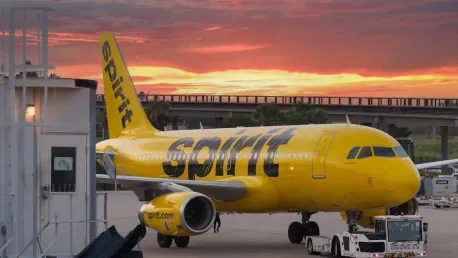Spirit Airlines filed for bankruptcy protection on Monday, facing a culmination of challenges that forced it into this position. These issues included mounting financial losses, significant debts, increased competition, and failed merger attempts. Despite the bankruptcy declaration, Spirit announced that its operations would continue uninterrupted while they work on restructuring their debt. Passengers would still be able to book flights, use their tickets, credits, and loyalty points as usual, reassuring customers that their travel plans wouldn’t be impacted during the restructuring period. Bankruptcy in the United States is often a strategic move for companies to reorganize and emerge stronger. History shows that most major US airlines, including American Airlines, United Airlines, and Delta Air Lines, have used bankruptcy to navigate through tough times over the past 25 years. Spirit is looking to follow this precedent, aiming to emerge early next year with a reduced debt load and greater financial flexibility. This new financial position is expected to facilitate long-term success and enhanced travel experiences for guests, alongside new investments propelled by an additional $300 million from creditors facilitating operations through the bankruptcy process.
However, Spirit’s future post-bankruptcy remains uncertain. The possibility exists that Spirit may either be acquired by another airline or face liquidation, similar to how several airlines have had their assets bought and merged after filing for bankruptcy. Additionally, Spirit disclosed that it employs nearly 13,000 full-time and part-time employees and another 8,000 independent contractors and temporary workers. Notably, the US Treasury Department is listed as their second-largest creditor, owed $136 million from an unsecured loan provided as part of federal support during the pandemic. While these funds were largely grants to keep airlines operational, a significant portion was also distributed as loans totaling $21.2 billion across the nation’s airlines.
Challenges Leading to Bankruptcy
Spirit Airlines has faced numerous challenges that have culminated in its bankruptcy filing. The airline has been grappling with mounting financial losses and significant debts, which have strained its financial health. Increased competition in the aviation market has also put pressure on Spirit, making it difficult to maintain profitability. The failure of recent merger attempts further complicated Spirit’s situation. The airline’s attempts to merge with Frontier Airlines were stifled, and efforts with JetBlue Airways were blocked by a federal judge on antitrust grounds, even after JetBlue outbid Frontier. These failed mergers left Spirit without the strategic partnerships it hoped would strengthen its position in the market, contributing to its current financial turmoil.
Spirit’s plight is not isolated but rather reflective of wider challenges within the airline industry, especially for budget carriers. The model of providing ultra-low base fares, while attracting cost-sensitive travelers, has also necessitated a volume-centric approach to achieving profitability. On average, a domestic round-trip economy fare on Spirit is priced at $136, significantly undercutting major carriers like American, United, Delta, and Southwest.
Spirit’s operational integrity hinges on these low prices, yet such a model demands operational efficiency and high passenger volumes, both of which suffered during the pandemic. Additionally, the competitive pressure exerted by Spirit pushed other airlines to introduce basic economy options, reducing margins across the industry. Therefore, as it faces bankruptcy, there is considerable concern about the potential reduction in competitive pressure if Spirit scales back operations or withdraws from select markets, which could inevitably lead to higher fare prices across the board.
Continuation of Operations
Despite the bankruptcy declaration, Spirit Airlines has assured its customers that operations will continue uninterrupted. Passengers can still book flights, use their tickets, credits, and loyalty points as usual. This reassurance is crucial for maintaining customer confidence during the restructuring period. The airline’s resilience in this regard underscores its commitment to ensuring that customers’ travel plans remain unaffected while it navigates through financial restructuring.
This confidence extends to the overall operational model of Spirit, which is pivotal in appealing to budget-conscious travelers. Providing ultra-low base fares has not only become synonymous with the Spirit brand but has also driven broader market dynamics by necessitating competitive pricing strategies among major players in the US aviation sector. As part of its plan to stabilize financially, Spirit aims to continue this model, albeit potentially adjusted to reflect the new financial realities post-restructuring.
Nonetheless, the airline’s future post-bankruptcy remains uncertain, echoing a broader sentiment within the industry regarding the fate of budget airlines. While Spirit’s restructuring plan involves emerging with an improved financial footing and operational stability, concerns linger about the eventual outcomes. Whether Spirit remains an independent entity, merges with another airline, or faces potential acquisition or liquidation, the airline’s strategy during bankruptcy will be crucial in determining its long-term viability and the impact on the broader aviation market.
Strategic Use of Bankruptcy
Bankruptcy in the United States is often a strategic move for companies to reorganize and emerge stronger. History shows that most major US airlines, including American Airlines, United Airlines, and Delta Air Lines, have used bankruptcy to navigate through tough times over the past 25 years. Spirit is looking to follow this precedent, aiming to emerge early next year with a reduced debt load and greater financial flexibility.
This new fiscal position is expected to facilitate long-term success and enhanced travel experiences for guests. Additionally, new investments propelled by an additional $300 million from creditors will facilitate operations through the bankruptcy process. The primary goal is to recalibrate its financial structure, ensuring long-term sustainability and the ability to reinvest in service enhancements. However, Spirit’s future post-bankruptcy remains uncertain, with the possibility of acquisition or liquidation still on the table. Past examples within the industry illustrate that bankruptcy can lead to numerous outcomes, from successful rejuvenation to eventual absorption by competitors.
The industry practice of leveraging bankruptcy for strategic advantage is rooted in the recognition that reorganizing debt and streamlining operations can create a more efficient and competitive business model. Spirit, with its considerable experience in the low-cost segment, appears poised to utilize this turbulent phase to recalibrate and potentially thrive in a redefined market landscape. The additional $300 million from creditors acts as a critical lifeline, ensuring uninterrupted operations and providing the necessary financial cushion to facilitate a balanced restructuring process.
Employment and Financial Disclosures
Spirit disclosed that it employs nearly 13,000 full-time and part-time employees and another 8,000 independent contractors and temporary workers. Notably, the US Treasury Department is listed as their second-largest creditor. The airline owes $136 million from an unsecured loan provided as part of federal support during the pandemic. While these funds were largely grants to keep airlines operational, a significant portion was also distributed as loans totaling $21.2 billion across the nation’s airlines. This highlights the interplay between federal support during crises and the financial operational challenges faced by carriers like Spirit.
Spirit’s financial disclosures have indicated active negotiations with lenders to restructure debt due to mature in 2025 and 2026. With $3.1 billion in long-term debt on its accounts, Spirit forecasts delisting from the New York Stock Exchange shortly. The airline also anticipates that the common stock will be canceled and rendered valueless after the restructuring process. The airline’s stock has seen a dramatic decline, with a drop of 59% following the announcement of negotiations and another 18% afterward, culminating in a 93% devaluation this year alone. These financial measures underscore the gravity of the situation and the extensive steps being taken to stabilize the company’s financial standing.
This extensive debt restructuring effort reflects the broader strategic initiative to not only manage the immediate financial challenges but also to create a sustainable operational framework for the future. The anticipated delisting from the New York Stock Exchange signifies a significant shift in Spirit’s corporate governance and financial strategy, aimed at long-term recovery and resilience. The workforce, particularly the substantial number of employees and contractors, plays a critical role in maintaining operational continuity and customer service standards during this transitional phase.
Impact on the Aviation Market
The potential acquisition of Spirit might encounter new dynamics. The urgency of bankruptcy and the threat of liquidation may alter the antitrust perspectives of regulatory bodies. Moreover, the upcoming administration changes, specifically the stance of President-elect Donald Trump’s Justice Department on corporate mergers, might be less stringent compared to the current administration under President Biden. These political and regulatory shifts may influence the landscape of potential mergers and acquisitions involving Spirit.
Spirit Airlines pioneered a low-cost, bare-bones service model in the US, charging for additional services such as carry-on baggage. However, this model also attracted a high volume of passenger complaints, placing Spirit and counterpart Frontier at the bottom of JD Power’s passenger satisfaction survey. Moreover, industry-wide concern persists that a JetBlue merger would spike fare prices, echoing the Justice Department’s position in blocking the previous deal. The broader implications for the airline industry, especially concerning fare competitiveness and service quality, remain pivotal in assessing Spirit’s future within the market.
The potential reconfiguration of Spirit, either through acquisition or operational recalibration, could significantly impact fare structures and competitive dynamics across the US aviation sector. As Spirit navigates through these uncertainties, the broader market will closely monitor how regulatory bodies balance antitrust concerns with the operational realities and financial health of budget carriers like Spirit.
Furthermore, there are ongoing deliberations on the overall future of the low-cost airline model, particularly in the wake of the significant financial turmoil witnessed by budget carriers during the pandemic. Spirit’s ability to maintain its low-cost advantage while addressing critical operational inefficiencies will be vital in shaping its long-term market presence and consumer perception.
Financial Measures and Future Outlook
Spirit Airlines filed for bankruptcy protection on Monday due to mounting financial challenges, including significant debts, financial losses, increased competition, and unsuccessful merger attempts. Despite this, Spirit assured that operations would continue without interruption, allowing passengers to book flights and use tickets, credits, and loyalty points as usual. This move is strategic, as many major US airlines, like American Airlines, United Airlines, and Delta Air Lines, have navigated bankruptcy to emerge stronger over the past 25 years. Spirit aims to follow this path, hoping to emerge early next year with reduced debt and enhanced financial flexibility. This new position is expected to lead to long-term success and better travel experiences, with an additional $300 million from creditors aiding operations during bankruptcy.
However, Spirit’s future remains uncertain, as it could be acquired or face liquidation, akin to how other airlines have been post-bankruptcy. Spirit employs nearly 13,000 full-time and part-time employees, and 8,000 independent contractors and temporary workers. The US Treasury Department is their second-largest creditor, owed $136 million from an unsecured loan provided during the pandemic. While many funds were grants to keep airlines afloat, loans totaling $21.2 billion were also distributed across the nation’s airlines.









